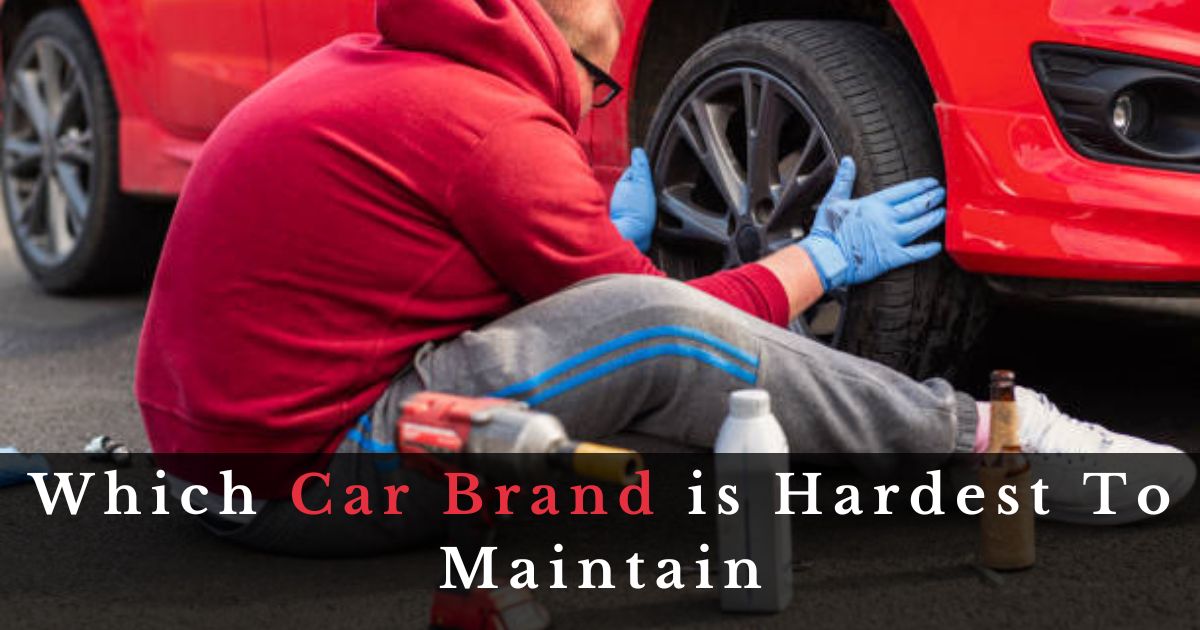Which car brand is hardest to maintain, When picking a car, most people look at the price, how it drives, and how it looks. But, the cost to keep the car running well can really add up. Some car brands are known for being hard and expensive to take care of. Let’s find out which car brands are the hardest to maintain and why.
Which Car Brand is Hardest to Maintain?
Introduction
Choosing the right car involves more than just picking one that looks good or fits your budget. One crucial factor to consider is how it is to maintain the vehicle. Maintenance can impact the longevity, performance, and overall cost of owning a car. So, which car brands are the hardest to maintain? Let’s dive into this topic to help you make a more informed decision.
Understanding Car Maintenance
What Car Maintenance Involves
Car maintenance includes routine tasks such as oil changes, tire rotations, brake inspections, and more complex repairs like engine or transmission work. Regular maintenance ensures that your car runs smoothly and prevents costly breakdowns.
Why Maintenance is Crucial for Car Longevity
Regular maintenance keeps your car in good shape, extends its lifespan, and enhances its resale value. Skipping maintenance can lead to severe issues that are much more expensive to fix than regular check-ups and minor repairs.
Factors Influencing Maintenance Difficulty
Complexity of Car Technology
Modern cars come with advanced technology, including computerized systems and sophisticated electronics. While these innovations improve performance and comfort, they also make repairs more complicated and often require specialized knowledge.
Availability of Parts
Some car brands use unique parts that aren’t readily available, making repairs more difficult and time-consuming. If parts need to be imported, it can also drive up the cost and delay the repair process.
Cost of Repairs
Luxury and high-performance cars often come with hefty repair bills. Specialized parts and skilled labor can significantly increase maintenance costs compared to more common, everyday vehicles.
Expertise Required
Certain car brands require mechanics with specialized training and tools. This can limit your options for repair shops and increase the difficulty and cost of maintaining your car.
Luxury Brands and Maintenance Challenges
Why Luxury Brands are Often Harder to Maintain
Luxury cars like BMW, Mercedes-Benz, and Audi come packed with high-end features and complex engineering. While this provides a premium driving experience, it also means that maintenance requires expert knowledge and expensive parts.
Examples of Luxury Car Brands
BMW: Known for its driving dynamics and luxury, but also notorious for costly repairs and maintenance.
Mercedes-Benz: Offers top-notch comfort and technology, with maintenance that often requires specialized expertise.
Audi: Combines luxury with sporty performance, leading to high maintenance costs due to sophisticated systems.
Sports Cars and Maintenance
High Performance and Its Impact on Maintenance
Sports cars are built for speed and performance, which puts extra strain on their components. Regular maintenance is crucial to keep these cars running at their, and repairs can be expensive due to the high-performance parts involved.
Common Maintenance Issues with Sports Cars
Frequent tire replacements: High speeds and aggressive driving wear out tires quickly.
Brake maintenance: Performance brakes need regular attention and can be costly to replace.
Engine and transmission: High-performance engines and transmissions require specialized care and parts.
European Cars: A Special Case
Unique Challenges with European Car Brands
European cars, while known for their engineering excellence and performance, often come with high maintenance requirements. They use unique parts and technologies that can be expensive and require specialized knowledge to repair.
Popular European Brands and Their Maintenance Difficulties
Volkswagen: Known for its reliability but can be challenging to maintain due to unique parts.
Jaguar: Offers luxury and performance but comes with high maintenance costs and part availability issues.
Volvo: Renowned for safety and durability, yet maintenance can be pricey and complicated.
American Cars: Easier or Harder?
Overview of American Car Brands
American car brands like Ford, Chevrolet, and Dodge are often considered easier to maintain compared to their European counterparts. Parts are generally more available and less expensive, and there are more mechanics familiar with these brands.
Maintenance Comparison with European and Asian Brands
American cars tend to be less complex and use more standardized parts, making them easier and cheaper to maintain. However, they may not offer the same level of engineering precision and luxury as European brands.
Asian Cars: Reliable but Not Always Simple
Reputation for Reliability
Asian car brands like Toyota, Honda, and Hyundai are known for their reliability and longevity. They often rank high in dependability studies and have a reputation for being low-maintenance.
Maintenance Challenges with Asian Car Brands
While generally reliable, some Asian brands use specialized parts that can be expensive or hard to find. High-end models from brands like Lexus and Acura may also require more intensive maintenance.
Electric Cars: The New Frontier
Maintenance of Electric Cars vs. Traditional Cars
Electric cars have fewer moving parts than traditional internal combustion engines, leading to potentially lower maintenance costs. However, they require specialized knowledge and tools for battery and electronic system repairs.
Brands Leading in Electric Car Maintenance Challenges
Tesla: Known for innovation but can be difficult to maintain due to proprietary technology and parts.
Nissan (Leaf): Generally reliable but requires specialized service for electric components.
Chevrolet (Bolt): Offers an affordable electric option with unique maintenance needs.
Classic Cars: A Nostalgic Challenge
Why Classic Cars are Hard to Maintain
Classic cars can be a joy to own but come with unique maintenance challenges. Parts can be scarce, and repairs often require specialized knowledge of older automotive technology.
Popular Classic Car Brands
Ford Mustang: Iconic but can be challenging to maintain due to part availability.
Chevrolet Camaro: A classic muscle car with maintenance needs that can be tough to meet.
Volkswagen Beetle: Beloved classic with parts that can be difficult to source.
The Role of Technology in Car Maintenance
How Advanced Technology Impacts Maintenance
Modern cars are equipped with advanced technology, including computerized systems, sensors, and sophisticated electronics. While these features enhance driving experience, they also make maintenance more complex and specialized.
Brands with the Most Tech-Driven Maintenance Challenges
Tesla: Heavy reliance on technology means maintenance often requires software updates and specialized tools.
BMW: High-tech features like advanced driver assistance systems can complicate repairs.
Audi: Known for cutting-edge technology that demands expert maintenance.
Maintenance Costs: Breaking Down the Expenses
Average Costs Associated with Maintaining Different Brands
Maintenance costs can vary widely depending on the brand. Luxury and high-performance brands often have higher maintenance expenses due to specialized parts and labor.
Most Expensive Brands to Maintain
BMW: Regular maintenance and repairs can be costly.
Mercedes-Benz: High-end parts and specialized service drive up costs.
Audi: Complex engineering and luxury features contribute to higher maintenance expenses.
Finding Reliable Mechanics
Importance of Finding Specialized Mechanics
Not all mechanics are equipped to handle the specific needs of every car brand. Finding a mechanic with expertise in your particular car brand is crucial for effective and reliable maintenance.
Tips for Finding Reliable Mechanics for Different Car Brands
Research and Reviews: Look for mechanics with good reviews and ratings specific to your car brand.
Certifications: Ensure the mechanic has certifications or specialized training.
Experience: Choose a mechanic with experience working on your car brand.
Maintenance Tips for Car Owners
Proactive Maintenance Tips
Regular Check-Ups: Don’t skip regular maintenance schedules.
Use Quality Parts: Opt for OEM or high-quality aftermarket parts.
Follow Manufacturer Guidelines: Adhere to the maintenance guidelines provided by your car manufacturer.
How to Reduce Maintenance Costs
DIY Maintenance: Handle simple tasks like oil changes and air filter replacements yourself.
Shop Around: Compare prices for parts and labor before committing.
Preventive Care: Address minor issues before they become major problems.
Conclusion
Maintaining a car is an essential part of ownership that can significantly impact its longevity and performance. While some car brands are notoriously harder to maintain, understanding the specific challenges can help you make a more informed decision when purchasing a vehicle. Consider factors like technology, part availability, and the expertise required for repairs. Ultimately, choosing a car that fits your maintenance comfort level and budget will lead to a more satisfying ownership experience.
FAQs
Which car brands are the easiest to maintain?
Brands like Toyota, Honda, and Ford are generally considered easier to maintain due to their reliability and the widespread availability of parts and skilled mechanics.
How often should I take my car for maintenance?
It’s recommended to follow your car manufacturer’s maintenance schedule, typically every 5,000 to 7,500 miles for routine services like oil changes and inspections.
Are newer cars easier to maintain than older models?
Newer cars often come with advanced diagnostics and longer intervals between services, making some aspects of maintenance easier. However, their complex technology can require specialized knowledge.
What is the most reliable car brand?
Toyota and Honda are frequently cited as the most reliable car brands, known for their durability and low maintenance needs.
How can I lower my car maintenance costs?
Regularly perform basic maintenance yourself, shop around for parts and labor, and address issues promptly to avoid more expensive repairs down the line.



